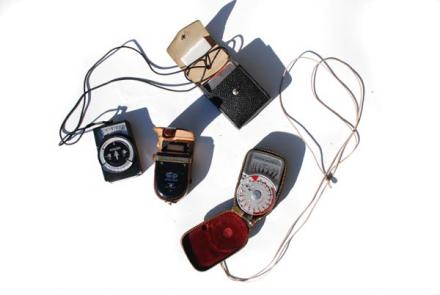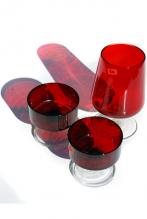Selenium
The metallic form of selenium conducts electricity over a thousand times more efficiently when light falls on its surface. For this reason its main use is in light meters, photocopier toner, photoelectric and solar cells.
One of the light meters pictured here is a Leningrad 8, made in 1985, presumably in Leningrad. Some of their light meters have the price printed on them from the factory, a sure sign of the Soviet command economy. One I came across was 75 roubles. Leningrad is also where the popular LOMO camera comes from, and it gets its name from this - Leningrad Union of Optics & Mechanics (the Leningradskoye Optiko-Mekhanicheskoye Ob'edinyeniye. The camera was originally intended as an espionage tool for KGB field agents.
One of the places selenium is produced (mainly as a by product of electrolytically refined copper) is Russia, so it wouldn’t have had far to travel from digging it out of the ground, to eventually going into the product, back in the days of the USSR.
Another one is called the “Foreign”, and I can’t find out where it came from. There’s also a Weston V, manufactured in Enfield, but the company had links to the USA and Canada, which is the likely source of the selenium it uses.
As well as being used to help measure light when taking photographs, selenium is also used as a photographic toner by Kodak, extending the colour range. It’s also an irreplaceable primary red colour die for cloth, and in glass manufacturing it’s used to make a ruby-red color such as the ones below, bought at the British Red Cross in Penrith.
Healthy nuts.
A food source that’s high in selenium is brazil nuts, and is found in many other nuts and testicles. One theory of the declining sperm rate in Western Europe is that some foods high in selenium content such as liver and kidney have fallen out of favour. Selenium is part of an enzyme in the body known as glutathione peroxidase. This enzyme helps deactivate some harmful substances that are created when we fight infections. It would be very rare, however, to actually have to take supplements, and can be toxic at slightly higher levels. Berzelius, who discovered selenium, got high on his own supply, and was afflicted by foul smelling breath.
Locoweed
There’s a lot of locoweed in the Western United States, particularly in the Great Plains, where catlle encounter a purple variety (Oxytropis lambertii). At certain times of year, it can be the only green plant available to grazing animals, and can be high in selenium. Ingestion causes symptoms including erratic behavior, aggression, lethargy, depression, loss of balance and nervousness. Locoweed is also a name for cannabis.
Patently useful
A New York times article, SELENIUM CELLS TO FIRE CANNON; W.J. Hammer Tells How a Sulphuric Acid By-Product Could Be Used in Time of War.
available in pdf format, here outlines some future-forecasting uses of selenium, from 1910, that include using it to automatically fire a cannon when an enemy warships searchlights triggered it. More useful applications that he thought of were in automating tasks such as lights going on and off at dusk and dawn, and in fire prevention.
Another inventive use of seleniums’ properties, now ubiquitous, had struggled to get off the ground for many years. Chester Carlson's conceived of xerography, which uses selenium’s light-enhanced conducting properties in photographic toner while copying by hand law books he couldn’t afford to buy. He became a patents attorney, whilst unsuccessfully trying to get companies interested for over 20 years. His presentation style, seen as disastrously poor, could well have been enhanced if he’d taken a little of selenium’s other useful properties as an anti-dandruff ingredient in shampoos.
When some of the same companies that earlier turned Carlson down thought about copying his discoveries, he had even patented the selenium that was a key element in the toner.
It pays to pollute
In the San Francisco Bay area, scientists found toxic levels of selenium in clams that a large variety of other species feed on. Selenium in the bay was found to come from a variety of sources, but the most dangerous source came from 6 oil refineries bordering the bay. In 1991 the regional water board ordered all of the refineries to drastically reduce selenium discharges by the end of 1993. Three complied, but Exxon, Shell and Unocal filed a suit, contending there was no economically feasible way to reduce selenium discharges.
As part of a settlement with the regional board, the three refineries agreed to pay $2 million for selenium research and comply with the new selenium limits at a date set five years later.
In the early 1980s, waterfowl in marshy areas of California's San Joaquin Valley started appearing with birth deformities. Scientists traced the cause of this disaster to selenium delivered by irrigation projects in the USA near the Colorado-Utah border, which were found to contribute up to 60% of the selenium in river water. Studies had found reproductive problems in ducks that migrate from Northern California to Alaska.
The ‘affordable’ removal of selenium from man-made processes is given a different twist at Berkley University in this article in the Berkeylan, which wants to exploit the natural take-up of selenium by rushes and grasses.
In the UK, airborne emissions of selenium have reduced by over 50% since the 1970’s mainly due to a switchover from coal to natural gas. The glassware industry now accounts for most of the airborne releases, though numerous studies are being conducted about the rise of aquaculture and its impacts on human consumption of fish byDEFRA.

